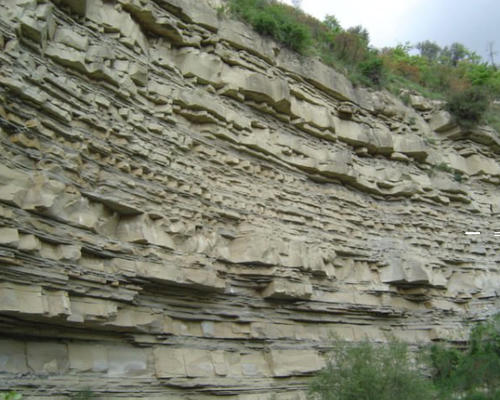Turbidite rocks as indicators of environmental change
Turbidite formation
Image Credit: Geologist CC BY SA 3.0
In the face of global change, it is becoming increasingly important to understand how the Earth's surface responds to climatic influences in order to make informed predictions about future environmental changes and their impact on sediment production and transport.
Turbidity currents are one of the most important sediment transport processes on Earth in terms of volume, and research into the rocks formed from turbidity currents (so-called turbidites) can provide information about climate changes in the past.
The data
The dataset contains numerous data on the age of seven investigated sediment cores from turbidite layers from the continental slope of Chile as well as data on past environmental conditions (so-called proxies) and on the turbidites themselves. The frequency and thickness of the turbidite layers were measured and normalised by statistical methods. The proxies have been divided into independent and dependent proxies and include the moisture index, pollen index, clay mineral compositions, grain size, salinity and sea surface temperature, as well as foraminifera population data.
Publication of the data set: Bernhardt A, Schwanghart W et al (2017) https://doi.pangaea.de/10.1594/PANGAEA.876590
Research results
By studying sediment cores from turbidites from the continental slope and in the deep-sea basin off the coast of Chile, it has been shown that turbidite deposits preserve information about the climatic transition from the Last Glacial Maximum (LGM) to the Holocene over a wide range of climatic zones and geomorphological settings.
At the arid and semi-arid study sites, the individual compartments of the sediment transport systems are interconnected and sediments could be efficiently transported towards the ocean. The return to dry climatic conditions after the LGM has led to a reduced transport capacity of the rivers. The rivers were therefore unable to transport the glacial sediments from the Andean hinterland. This quickly manifested itself in a decrease in the deposition of turbidites in the ocean during this time.
At the southern study site, characterised by humid climatic conditions, the similar temporal pattern of turbidite deposition is mainly attributed to the sudden loss of the connection between the Andean erosion zone and the sediment transfer zone by newly forming glacial lakes. This also makes it clear that similar frequencies of turbidite deposition can be caused by different mechanisms.
Publication of the journal article: Bernhardt A, Schwanghart W et al (2017) https://doi.org/10.1016/j.epsl.2017.05.017
Texts modified after: Bernhardt A, Schwanghart W et al (2017) https://doi.org/10.1016/j.epsl.2017.05.017
